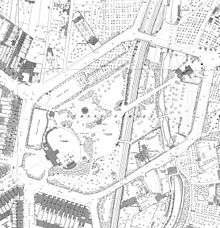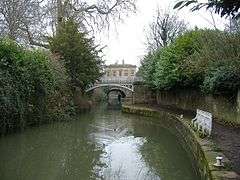Sydney Gardens
| Sydney Gardens | |
|---|---|
|
The Kennet and Avon Canal bridges within the park | |
 | |
| Location | Bath, Somerset, England |
| Coordinates | 51°23′10″N 2°21′00″W / 51.3862°N 2.3499°WCoordinates: 51°23′10″N 2°21′00″W / 51.3862°N 2.3499°W |
| Area | 4 hectares (9.9 acres)[1] |
| Created | 1792 |
| Operated by | Bath and North East Somerset |
| Open | All year |
Sydney Gardens (originally known as Bath Vauxhall Gardens[2]) is a public open space at the end of Great Pulteney Street in Bath, Somerset, England. The gardens are the only remaining eighteenth-century pleasure gardens (or Vauxhall) in the country.[3]
The gardens were laid out in the 1790s as a commercial pleasure garden with a variety of attractions. The layout has been affected by the construction of the Great Western Railway and Kennet and Avon Canal which pass through the park, and later fell into decline. In 1908 the site was bought by the local council and reopened as a park.
The Sydney Hotel, which was built with the gardens, was the centre for entertainment. It is now the Holburne Museum of Art. Other structures including the walls and bridges connected with the canal and railway are listed buildings along with small buildings now known as the pavilion and Minerva's temple and the public conveniences.
History


The gardens were constructed in the 1790s opening in 1795 as a commercial pleasure grounds, following the development of Bathwick by Sir William Pulteney, 5th Baronet, across the River Avon from the city centre. The original plans were by Thomas Baldwin and completed by Charles Harcourt Masters who included a maze or labyrinth,[4] grotto, sham castle and an artificial rural scene with moving figures powered by a clockwork mechanism.[5] The gardens were illuminated by over 15,000 "variegated lamps".[6]
Around 1810 the Kennet and Avon Canal was built through the gardens and then in 1840 the route of the Great Western Railway also cut through the area. In the 1860s a gymnasium and bandstand were constructed and courts laid for tennis, archery and croquet. In 1891 the original 99-year lease of Sydney Gardens expired and it was sold. The site was bought by Bath City Council in 1908 and reopened to the public in 1913.[7]
In 2015 a £250,000 project to improve the environment of the park and public access was announced.[8]
Sydney Hotel

The Sydney Hotel was built within the gardens. The original design for the hotel, prepared by Thomas Baldwin in 1794, was a two-storey building which would serve the pleasure gardens. After Baldwin was bankrupted his design for the hotel was not implemented. Instead a three-storey building was designed by Charles Harcourt Masters.[9] The foundation stone was laid in 1796 and the building was ready by 1799. Visitors entered the gardens through the Hotel. Projecting from the rear of the building at first floor level was a conservatory and a semi-circular Orchestra with a wide covered loggia below. Two semi-circular rows of supper boxes projected from the sides of the building. The gardens were used daily for promenades and public breakfasts which were attended by Jane Austen among others.[10] At public breakfasts tea, coffee, rolls and Sally Lunn buns were served at about midday, followed by dancing. There were generally three evening galas each summer, usually on the birthdays of George III and the Prince of Wales, and in July to coincide with the Bath races. During these galas the gardens were lit with thousands of lamps and the guests took supper accompanied by music and fireworks. Breakfasts, coffee-drinking, newspaper-reading and card-playing took place in the ground floor of the Hotel and dancing in a ballroom on the first floor. All the rooms could be hired for private parties and meetings.[11] In 1836 the Hotel was changed into a private lodging house and an extra storey of bedrooms added. The two watchman's boxes outside the museum were added around 1840.[12] From 1853 until 1880 the building was let to the Bath Proprietary College. In 1891 the original 99-year lease of Sydney Gardens expired and its financial affairs had to be wound up. The Hotel and gardens were then sold. The building remained empty and derelict until 1913 when it was acquired by the trustees of the Holburne of Menstrie Museum. Sir Reginald Blomfield was appointed to carry out the extensive restoration and alterations necessary to render the building suitable for museum purposes. The new Holburne Museum of Art opened to the public on 6 June 1916.[13]
Other structures
The 12 metres (39 ft) high Minerva's Temple was built in 1911 for the Festival of Empire at The Crystal Palace. It was then moved to Sydney Gardens. The front of the building has four fluted Corinthian columns.[14] The pavilion was originally a gardeners cottage or lodge when it was built around 1840, it was later used as a cloakroom.[15]
The Kennet and Avon Canal passes through the gardens via two short tunnels[16][17] and under two cast iron footbridges dating from 1800.[18] Cleveland Tunnel is 173 feet (53 m) long and runs under Cleveland House, the former headquarters of the Kennet and Avon Canal Company[19] and now a Grade II* listed building.[20] A trap-door in the tunnel roof was used to pass paperwork between clerks above and bargees below.[19]
There is also a footbridge over the railway which was designed by Isambard Kingdom Brunel and built in 1840,[21] as were the retaining walls.[22][23]
Even the public conveniences are listed buildings.[24][25]
Gallery
 Minerva's Temple
Minerva's Temple Bridge in Sydney Gardens
Bridge in Sydney Gardens- Iron footbridge over the Kennet and Avon canal, Sydney Gardens, Bath
- Iron footbridge over the Kennet and Avon canal, Sydney Gardens, Bath
References
- ↑ "Sydney Gardens, Bath, England". Parks and Gardens UK. Retrieved 15 June 2013.
- ↑ "Kennet & Avon Canal Trail". Canal & River Trust. Retrieved 2 August 2016.
- ↑ "Jane Austen and Bath: The Sydney Gardens". Austenonly. Retrieved 15 June 2013.
- ↑ Downing, Sarah Jane (5 April 2009). "Green and pleasant". Guardian. Retrieved 15 June 2013.
- ↑ "Sydney Gardens". National heritage list for England. English Heritage. Retrieved 15 June 2013.
- ↑ Bond, James (1998). Somerset Parks and Gardens. Tiverton: Somerset Books. pp. 98–99. ISBN 0861834658.
- ↑ "Sydney Gardens, Bath, England – History". Parks and Gardens UK. Retrieved 15 June 2013.
- ↑ "Sydney Gardens". Bath and North East Somerset Council. Retrieved 22 March 2015.
- ↑ "The Holburne Museum". National heritage list for England. English Heritage. Retrieved 15 June 2013.
- ↑ Boyle, Laura. "Sydney Gardens, Bath". Jane Austen Centre. Retrieved 15 June 2013.
- ↑ "Collection history". Holburne Museum. Retrieved 15 June 2013.
- ↑ "A pair of watchmen's boxes flanking the entrance to the Holburne Museum". National heritage list for England. English Heritage. Retrieved 15 June 2013.
- ↑ "Holburne Museum". Culture 24. Retrieved 15 June 2013.
- ↑ "Minerva's Temple". National heritage list for England. English Heritage. Retrieved 15 June 2013.
- ↑ "Pavilion". National heritage list for England. English Heritage. Retrieved 15 June 2013.
- ↑ "Kennet and Avon tunnel (under Beckford Road)". National heritage list for England. English Heritage. Retrieved 15 June 2013.
- ↑ "Kennet and Avon tunnel (under Cleveland House and Sydney Road)". National heritage list for England. English Heritage. Retrieved 15 June 2013.
- ↑ "Bridge in Sydney Gardens". National heritage list for England. English Heritage. Retrieved 15 June 2013.
- 1 2 Pearson, Michael (2003). Kennet & Avon Middle Thames:Pearson's Canal Companion. Rugby, UK: Central Waterways Supplies. p. 13. ISBN 0-907864-97-X.
- ↑ "Cleveland House". National heritage list for England. English Heritage. Retrieved 15 June 2013.
- ↑ "Sydney Gardens Footbridge (MLN110614)". National heritage list for England. English Heritage. Retrieved 15 June 2013.
- ↑ "Retaining wall and balustrade west of railway line". National heritage list for England. English Heritage. Retrieved 15 June 2013.
- ↑ "Retaining wall east of railway line". National heritage list for England. English Heritage. Retrieved 15 June 2013.
- ↑ "Ladies public lavatories". National heritage list for England. English Heritage. Retrieved 15 June 2013.
- ↑ "Gentlemen's public lavatories". National heritage list for England. English Heritage. Retrieved 15 June 2013.
External links
| Wikimedia Commons has media related to Sydney Gardens. |
- Sydney Gardens consultation, Bath and North East Somerset Council, 13 June 2016
